2008-06-30 (Flight #2016) |
Flight Photo Album |
Aircraft Flight SummaryDate: 2008-06-30 |
Flight Track Map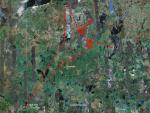
Larger image (new window) Download KMZ/KML File (right click, save as) |
Satellite Image from MODIS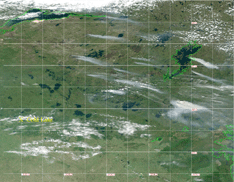
MODIS/Terra larger image (morning) (new window) MODIS/Aqua larger image (afternoon) (new window) |
Satellite Images from GOES-11 1715 - 2346 UTC |
CAR - (QuickLook)
Imagery from CAR Instrument
Click browse image thumbnail to load more detailed version (images open in a new window)
| Flight Direction | Flight Direction |
|
|
|
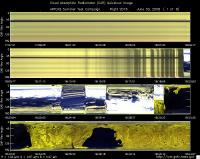
|
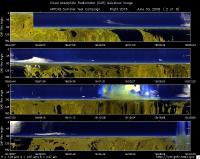
|
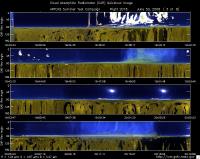
|

|
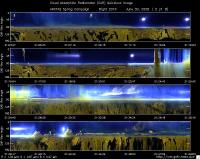
|
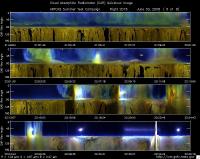
|
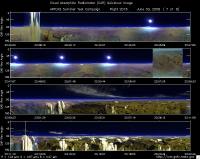
|
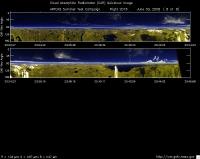
|
Flight Mission Details
Overview:
This was the third flight out of Cold Lake, Canada. Science goals include: 1) radiative forcing and closure measurements in cloud free air over plumes in stages of development, 2) CALIPSO inter-comparison with B200 in plume, 3) Fire plume under-flight with B200 w/P-3B below, 4) explore aerosol and optical differences in flaming (dark and smoldering (light) fire plumes near source, 5) fly fire outflow plume for aerosol ageing, characterize aerosol/cloud interactions near inversion, and 7) model validation
P-3B instrument payload:
AATS: Ames Airborne Tracking Sunphotomter (AATS. worked well.
AERO3X: Partially successful. Good red and blue scattering.
BBR: No problems reported.
CAR - Cloud Absorption Radiometer measured angular distribution of scattered radiation and acquired imagery of cloud, smoke, and surface. Filter wheel channel has initial problems.
CCN Counter - Continuous-Flow Streamwise Thermal Gradient Cloud Condensation Nuclei (CCN) Counter (CFSTGC) -No problems reported.
COBALT - Carbon monOxide By Attenuated Laser Transmission (COBALT), an autonomous instrument based on off-axis integrated cavity output spectroscopy. Collected good data.
HiGEAR - Hawii Group for Environmental Aerosol Research (HiGEAR) suite of instrument. Excellent flight.
PDS Project Data System (PDS) measured base meteorological and navigational measurements. Fully operational.
REVEAL - The Research Environment for Vehicle-Embedded Analysis on Linux (REVEAL) system is a prototype next-generation tool for aerospace vehicle sensor webs and the future Earth Observation System. Operational the whole flight.
SSFR -Solar Spectral Flux Radiometer. Reported good data.
Summary (Colleen Kelly, 29 June 2008):
Excellent: A GOLDEN DAY -- Great flight with all objectives met in 4.5 hours. Co-ordinated CALIPSO underflight with AOD and in-situ microphysics. Plume differences characterized in “black - flaming” and “white - smoldering” plumes, both chemically and optically. Successful coordination of in-situ and radiation in B200 lidar curtain. Aerosol physiochemical and optical evolution in ageing plumes. CAR BRDF measurements over biomass smoke pall (first ever!). Radiative properties inside smoke plumes reveal strong wavelength dependence consistent with enhanced shortwave absorption from the elevated organics measured. Nitrates also a record at 345ug/m3 near top of plume. Radiative flux stacks successful in crosswind legs above and below plume. AOD data in clear air for most plume and smoke layers studies including profiles. Plumes and Asian pollution layer with dust sampled at 17,500’ on return to Cold Lake very consistent with that predicted by GEOS-5. Smoke aerosol and cloud interactions explored.
Flight Path, Timing, and Measurements
Approximate time in UTC ( Local Edmonton/Cold Lake time: -6 hours). Activities during CAR flight 2016 on June 30, 2008 out of Cold Lake, Canada. Observations by CAR operator/PI, Charles Gatebe. Some notes adapted from a report by Antony Clarke, flight scientist.
17:50 -- CAR door opened manually in preparation for take off.
17:55 -- CAR computer and CANS power on.
17:58 -- CAR power on;scanning downwards on the runway.
18:00 -- CANS saving data.
18:16 -- engines on.
18:20 -- CAR scanning the runway.
18:21 -- CAR scanning the sky and in park position.
18:23 -- taxing.
18:28 -- take off.
18:30 -- CAR in active mode.
18:34 -- 9500' scatter 40Mm-1. (Antony Clarke)
18:36 -- cryocooler power on.
18:36 -- 12500' scatter 40Mm-1. (Antony Clarke)
18:37 -- 12500' in high organic layer (AMS). (Antony Clarke)
18:44 -- SO4 up, and f(RH) up. (Antony Clarke)
18:47 -- Sebastian expresses interest in CAR measurements taken in the starboard especially during radiation legs.
18:52 -- 10200' in clean layer. (Antony Clarke)
18:54 -- 11500' CN-130 / cc all volatile, O3 -22; CO -105 ppb. (Antony Clarke)
18:55 -- clouds above and to the right.
18:58 -- Filter wheel channels not stable.
1900 -- 8200' bump and concentrations increasing; heading for fires to fly plume. (Antony Clarke)
19:11 -- 1000'; fire plume. (Antony Clarke)
19:14 -- in plume 1 ppm CO; )3 - 45; AOD 2-3. (Antony Clarke)
19:16 -- climb to reach CALIPSO. (Antony Clarke)
19:19 -- Filter wheel channels not stable.
19:22 -- entering a very clear area.
19:28 -- 58deg 14', 106 deg 58' about to hit pyrocomulus outflow - dark plume.
19:29 -- entering outflow region of a heavy plume. Flying at 3.2 km. (Antony Clarke)
19:33 -- 2.1 micron not stable.
19:36 -- bumpy.
19:42 -- under CALIPS with B200, winds at 315 deg; 25 knots. (Antony Clarke)
19:48 -- plume to the right.
19:49 -- entering a plume.
19:55 -- 2.1 micron stable.
20:00 -- spiraling up.
20:06 -- 2.1 micron still stable.
20:09 -- entering a smoke plume.
20:12 -- descend to 500' leg. (Antony Clarke)
20:17 -- do 2 CAR circles waiting for B200. (Antony Clarke)
20:18 -- doing BRDF circles, 600 ft agl.
20:22 -- end of CAR circles. Ozone reported as 41 ppb.
20:25 -- start 500' run to SW; 58 deg 08', 104 deg 20'. (Antony Clarke)
20:26 -- beginning of radiation run.
20:34 -- end of low level leg. Climbing up.
20:37 -- end of upper level run.
20:49 -- level at 14,500'. (Antony Clarke)
20:50 -- on track under B200; start leg to NE.
20:51 -- end of 14500' run and start spiral descent to 6000' ft/min; AOD 0.03 over haze. (Antony Clarke)
21:02 -- start of medium leg.
21:05 -- 2.1 micron still stable.
21:11 -- end of medium level leg.
21:16 -- roll has a problem.
21:19 -- pick a closer fire. (Antony Clarke)
21:20 -- 2.1 micron - increase in signal at 70 deg while flying through smoke plumes. (scan no. 21138).
21:23 -- hit a dark pyrocu just at cloud back in new cloud top with black smoke. (Antony Clarke)
21:25 -- start long downwind run at 7000'. (Antony Clarke)
21:26 --57deg 12', 104deg,08' heading 080 deg. (Antony Clarke)
21:32 -- Ci and Cu above. (Antony Clarke)
21:33 -- flying through smoke plumes.
21:40 -- 2.1 micron - increase in signal in smoke plumes.
21:40 -- spiral to 1000' before other plumes mix into ours. Reverse heading and retrace plume. (Antony Clarke)
21:43 -- start 1000' under plume.
21:44 -- start of run at 1000' agl.
21:52 -- plume appear to have drifted south of track a bit, wind is 15 knots at 338 deg; AOD 2. (Antony Clarke)
21:58 -- AOD from 2.4 to 3.2 at 499 nm.
22:00 -- end run 57deg 18', 104deg, 23'. (Antony Clarke)
22:02 -- start cross wind leg at 500' (400msl).(Antony Clarke)
22:06 -- reverse plume and cross plume back to north. (Antony Clarke)
22:12 -- into clean air -- turn back into plume. (Antony Clarke)
22:14 -- reversing the course back to the plume.
22:16 -- spiral up at 57deg 17', 104deg 42'; scatter 1000Mm-1 at 6000'. (Antony Clarke)
22:17 -- spiraling up through the plume.
22:24 -- passing through smoke plume.
22:25 -- near top of plume, AMS 345µg/m3 nitrate - highest ever. (Antony Clarke)
22:28 -- 14300' skim top of pyroCu; tops about 15000. (Antony Clarke)
22:33 -- Cu tops in smoke - make cloud penetration. (Antony Clarke)
22:34 -- over cloud top.
22:36 -- penetrate smoke (evaporated cloud) and then into cloud. (Antony Clarke)
22:37 -- over clop top.
22:41 -- John Cooper --attributes the spikes seen in the 2.1 micron to hot flames.
22:42 -- 3 CAR circles over smoke cloud - couple of Ci streaks. (Antony Clarke)
22:43 -- BRDF circle 1.
22:46 -- circle 2.
22:49 -- switch filter wheel channel to 1..6 micron.
22:52 -- end of circle 3.
22:55 -- end of CAR circles over smoke.
22:56 -- smoke very thick. Can't see the ground.
23:04 -- large smoke plumes and clouds. Spikes in the data (21. micron) due to fire flames.
23:05 -- Cirrus cloud above. Small cumulus below aircraft.
23:12 -- penetrate top of PyroCu cloud top (pic taken) - smoke pumping out of it. 36deg 29', 106deg 35'. (Antony Clarke)
23:15 -- over pyrocumulus. Spiking in 2.1 micron channel.
23:30 -- elevated plume aloft, high sulfate, dust (30% of scatter due to dust). (Antony Clarke)
23:32 -- cirrus above and cu below.
23:33 -- 2.1 micron stable. CAR Imaging in the starboard.
23:37 -- start of descent.
23:46 -- CAR door closed and CAR parked in preparation for landing. CAR power off.
23:53 -- land (Tony recorded: 22:52).
23:57 -- end of taxing. CANS power off.
